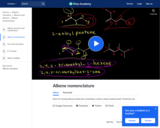
Figuring how long it takes an a380 to take off given a constant acceleration
- Subject:
- Physical Science
- Physics
- Material Type:
- Lesson
- Provider:
- Khan Academy
- Author:
- Sal Khan
- Date Added:
- 09/22/2013

Figuring how long it takes an a380 to take off given a constant acceleration

As reduced sea ice conditions bring increased shipping and development opportunities to the Arctic, Alaska Native Village Corporations are at the table with resource developers, representing the interests of their people and land.

Alcohol Properties

Naming alcohols

Aldehyde introduction

Aldol Reaction

In this video, we explore some concepts fundamental to algebra. To streamline the discussion of relationships between physical quantities, we introduce variables, functions, composition, and inverse. By thinking about the concept of an inverse function, we obtain our first glimpse of the imaginary root (i.e. square-root of -1) and the complex plane.

Out in the vast coldness of outer space, there are planets that travel alone through darkness without the boundaries of a system. Here's how this can happen - and why these frozen deserts might secretly harbor alien life. The video "Aliens under the Ice - Life on Rogue Planets" is a resource included in the Space sciences topic made available from the Kurzgesagt open educational resource series.

This video is from the Khan Academy subject of Science on the topic of Organic chemistry and it covers Alkene intro and stability.

This video is from the Khan Academy subject of Science on the topic of Organic chemistry and it covers Alkene nomenclature.

The video resource "Alkenes & Alkynes - Crash Course Chemistry #41" is included in the "Chemistry" course from the resources series of "Crash Course". Crash Course is a educational video series from John and Hank Green.

Is climate change real? Yes, it is! And technologies to reduce Greenhouse Gas (GHG) emissions are being developed. One type of technology that is imperative in the short run is biofuels; however, biofuels must meet specifications for gasoline, diesel, and jet fuel, or catastrophic damage could occur. This course will examine the chemistry of technologies of bio-based sources for power generation and transportation fuels. We'll consider various biomasses that can be utilized for fuel generation, understand the processes necessary for biomass processing, explore biorefining, and analyze how biofuels can be used in current fuel infrastructure.

Aluminium is element 13 on the periodic table. This video is one of the 118 clips included in the periodic table of elements themed collection created by Brady Haran and the University of Nottingham in the UK.

Students learn how nanoparticles can be creatively used for medical diagnostic purposes. They learn about buckminsterfullerenes, more commonly known as buckyballs, and about the potential for these complex carbon molecules to deliver drugs and other treatments into the human body. They brainstorm methods to track buckyballs in the body, then build a buckyball from pipe cleaners with a fluorescent tag to model how nanoparticles might be labeled and detected for use in a living organism. As an extension, students research and select appropriate radioisotopes for different medical applications.

Environmental History is about looking at the past as if the environment matters. American History is about looking at the past of not only the United States, but of both the American continents. This wider view is especially important when we realize that people occupied the Americas for over 15,000 years before Europeans arrived and that when the came to the Americas, Europeans focused their interest for centuries on areas that are not part of the current United States. As we get closer to the present, we will focus more on the U.S., but we’ll try to remind ourselves from time to time that we’re not the only nation in the Americas by considering how other nations have experienced and affected the environment.

Americium is element number 95. This video is one of the 118 clips included in the periodic table of elements themed collection created by Brady Haran and the University of Nottingham in the UK.

Amide Formation from Acyl Chloride

Amine Naming 2

Amine Naming Introduction

The lesson begins with a demonstration introducing students to the force between two current carrying loops, comparing the attraction and repulsion between the loops to that between two magnets. After formal lecture on Ampere's law, students begin to use the concepts to calculate the magnetic field around a loop. This is applied to determine the magnetic field of a toroid, imagining a toroid as a looped solenoid.